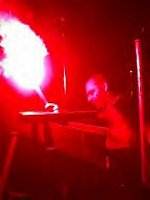
Music and film are so interconnected that it is now becoming very common
to find silent movies being accompanied by live music in concert. This has
happened with Carl Davis' sprawling and dramatic scores, often hours long,
and happened on Wednesday night at the South Bank in a showing of F W
Murnau's classic horror flick, Nosferatu. The difference
was entirely in the accompaniment which was played by German Krautrock group,
Faust.
Faust were formed in 1971 in Wumme. They were part of a disparate 'Kraut Rock' movement that became briefly fashionable among a hippyish in-crowd and were influential on other groups appearing during the same period - Kraftwerk, Amon Duul II, Cluster, Guru Guru and Ash Ra Tempel. The industrial technique of their music making, heavily based on improvisation, became one of the formative directions for later German rock music -the bands Neubaten, Freudiana, Uilab and Schneider TM are notable children from this bastardised marriage. Richard Branson probably owes more to the band's lasting fame than anyone else when in 1973 he released their fourth album, The Faust Tapes, at 49p - the price of a single 45rpm record. It came complete with a cover of Bridget Riley's painting Waves. The band disbanded in 1975, its members scattering across Germany, and only reformed in the 1990s. Faust Wakes Nosferatu was first released on album in 1998 and is the progenitive raison d'être for this live screening (but the album itself now seems unavailable - how ironic!).
The Hippyish influences have not entirely disappeared. Before the actual screening of Nosferatu the large screen was taken up with gyrating psychedelic images played to an accompanying soundtrack. This was later replaced with cameras panning around the Festival Hall, spying on concert goers moving towards their seats in the auditorium, like a peeping Tom.
Murnau's 1922 Nosferatu is the first Dracula film and, for many, is still unmatched. Although not his best film, it is probably his most famous, and is still today amongst the most poetic and sheerly beautiful of all horror films. The camera work, use of light and creation of atmosphere are all evolutionary. Murnau's 1926 Faust took this to previously unmatched levels where the visually extraordinary scenery is presented like paintings from the German, Dutch or Italian masters. The expressiveness of the camerawork goes hand-in-hand with an almost Renaissance beauty that captures the near impossible on film.
Faust were not always adept at capturing the beauty of the camerawork in a similar beauty of orchestration. However, there were moments when the darkness of the film suddenly gave life to a bursting, brightness of light. A firework display of sparks were unleashed from chainsaws and road drills being smashed against sheet-metal, a roaring flame was produced from a brazier centre stage, and rotating lights threw greens, reds and blinding whites onto the stage and against the walls. Most of the lead work during the entire film comes from electric guitar, but there is also a strong rhythmic backing either from drums and percussion or from bass and keyboards. The film has its moments of solitude and angst where the music making takes its cue from what is happening on screen. Some of the pregnancy given to these subliminal moments was defining, with a cosmic, otherworldliness that riveted the attention.
If Murnau's film has its timeless image in the character of Max Schreck's rat-like Nosferatu, with wizened body and talon like fingers, then Faust's central character is the drummer and part-narrator, Werner 'Zappi' Diermaier. A volatile musician, he led the other band members through an enlivening, dramatic couple of hours of inspired music making. There were sudden shocks - like the funeral march on screen being paced like a Wagnerian death-fugue from the stage, or a flute that splayed its notes through a microphone like a seismic tremor. The free form jazz influences were still there, as was the Stockhausen-like experimentalism and the proto-punkish minimalist cadences from their continuing collaboration with Tony Conrad.
This was improvisation on the highest level and an evening that was as challenging and memorable as any I have encountered.

Amazon
UK £14.99
Marc Bridle
 Return to:
Return to: